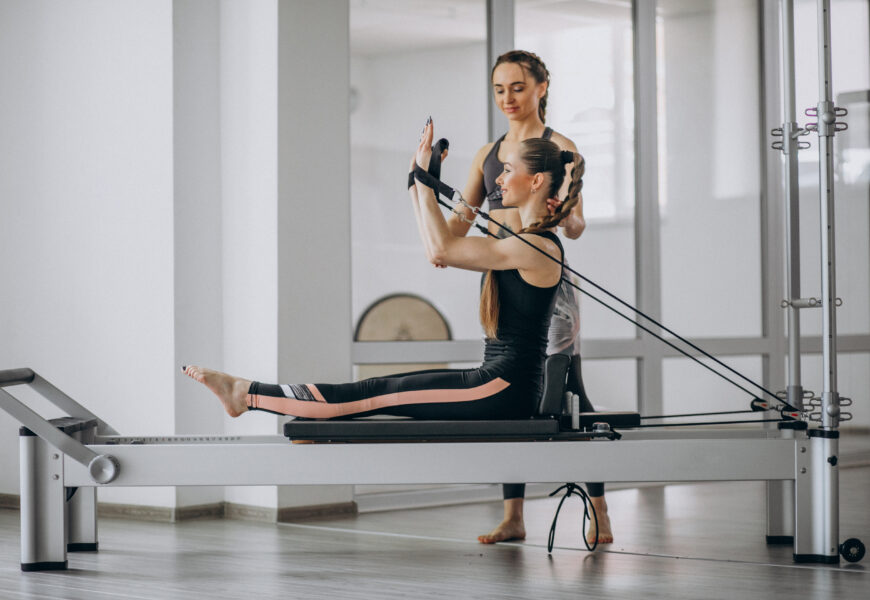It is essential to determine is pilates considered strength training and to understand its effects on the human body. Unlike strength training, which involves building muscle mass and increasing resistance, Pilates focuses on strengthening one’s core, ability to stretch, and slow controlled movements. The primary goal of this blog post is to draw attention to the distinctions between these two strategies and offer some great Pilates exercises. This will let you know more about how both methods relate to general fitness, weight loss, and physical well-being.
This guide has everything you need if you want to help tone muscles, improve posture, or burn calories fast enough. Let us see how these two methods can complement and effectively provide diverse paths toward achieving your fitness goals.
Source: Freepik
Pilates V.S Strength Training: Key Differences Explained
Losing Weight
Pilates, which focuses on strengthening the muscles and the core, can help someone acquire a slimmer figure. Good posture is promoted by solid core muscles that are responsive and flexible, allowing better movement efficiency during exercise. In contrast, strength training produces exceptional fat loss results because it leads to muscle hypertrophy that increases metabolism rates and burns calories. Compound movements involving several different muscles, like squats or deadlifts, help save energy over extended periods, reducing fat.
Techniques
Pilates involves deliberate, slow movements focusing on specific muscle groups but demanding control, flexibility, and endurance. Moreover, it utilizes one’s weight, enhances the strength of muscles all over the body, and develops joint mobility. Conversely, strength training centers around progressive overload and helps achieve muscle mass. In addition, compound exercises that form a central part of the different workouts under strength training target large muscle groups effectively for muscle growth.
Advantages
Each has unique benefits that serve different fitness goals. In Pilates, strengthening core muscles and increasing flexibility and range of motion requires performing controlled movements with one’s weight. This exercise enhances functional fitness among participants, thereby reducing injuries and promoting concentration levels through mindful movements.
On the contrary, strength training emphasizes muscle hypertrophy, strength gains, and metabolic benefits. Gradually raising the load through various weights and other machine methods initiates muscle growth by increasing pressure on them. Such a workout is ideal for athletes who want to gain more than lose weight alone. Besides helping individuals maintain healthy weights, such training enhances physical functioning, producing better overall health. So, if someone is looking to achieve comprehensive fitness goals, they must include both these forms of exercise.
Must-Try Pilates Exercises
These are a few Pilates exercises you can do without any equipment at home. Their primary focus is on posture correction, mobility, and core strengthening. Let’s examine each one separately.
Source: Freepik
Pillar Bridge
Another name for Pillar Bridge is a plank, which focuses on those muscles supporting the body in general movements.
How to Do It?
Lower yourself into a plank posture, keeping your feet hip-width apart and your elbows directly under your shoulders. Lift your knees off the floor, contract your core, and stretch your legs. Do the same for a while to see results.
Runners Lunge
This exercise helps improve hip mobility and flexibility, which are essential to counteract the effects of sitting all day.
How to Do It?
With one foot forward and one knee on the floor, begin in a low lunge position. Place hands inside the front foot, lift the back knee up, straighten the leg behind you, and return to the starting position.
Downward Dog
After spending too much time sitting, the posterior chain becomes strained, which affects our backs. This exercise stretches it out.
How to Do It?
Tuck your toes and place your hands shoulder-width apart while lying on your back. Lift your hips toward the ceiling and assemble your torso into a triangle. Press your heels into the mat while maintaining contact with your hands.
Besides strengthening and stretching essential muscle groups, these exercises encourage better posture and movement, making them indispensable for any home Pilates workout. Alternatively, try professional workouts or search for online fitness platforms if you need more structured guidance.
To Sum It Up
Ultimately, Pilates and strength training differ in terms of shedding pounds, processes, and the benefits that come from it. Also, using controlled movements and resistance provided by one’s body’s weight, Pilates helps improve muscle tone, core strength, and flexibility. It also improves posture and mobility, making it suitable for functional fitness and injury prevention. Conversely, strength training focuses on muscle hypertrophy and metabolic advantages through increasing resistance levels progressively using weights or resistance bands. This exercise helps develop muscle strength alongside bone density and overall performance in person. Therefore, a combined approach to fitness incorporating both can effectively achieve diverse health goals over time.
References
https://www.self.com/story/does-pilates-count-as-strength-training







